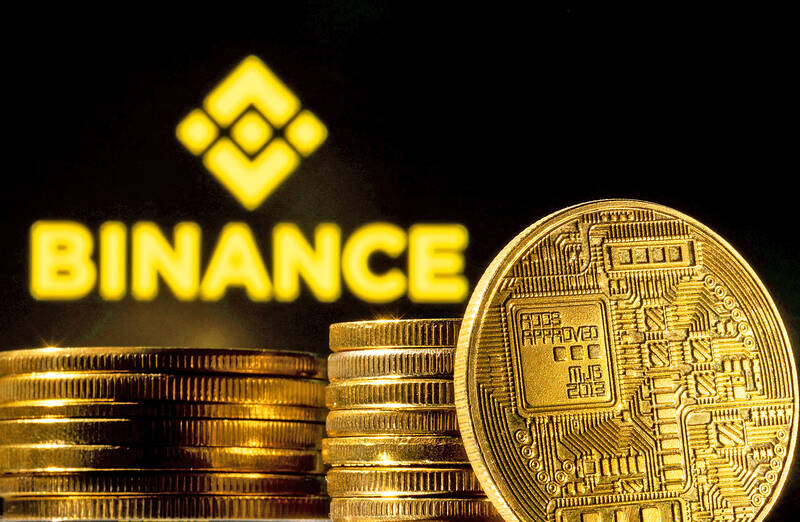Binance restarted withdrawals of bitcoin after citing congestion on the token’s blockchain for two halts in less than 12 hours, suspensions that weighed on cryptocurrency markets.
The company said higher fees have been applied to pending transactions, so they get picked up by bitcoin miners — the computer rigs that operate the network. Withdrawals were down for more than two hours yesterday in Asia.
“To prevent a similar recurrence in the future, our fees have been adjusted,” it said. “We will continue to monitor on-chain activity and adjust accordingly if needed.”

Photo: REUTERS
Binance had also halted bitcoin withdrawals on Sunday for about 90 minutes, blaming congestion on the token’s blockchain.
Data from research company CryptoQuant showed that the platform experienced its highest-ever net daily outflow of bitcoin — a net 175,646 tokens — on Sunday.
Binance moved about US$4.4 billion worth of bitcoin across its digital-asset wallets on Sunday, analysis from CryptoQuant showed.
The tokens were moved in two tranches, of 117,000 and 40,000, CryptoQuant research head Julio Moreno wrote on Twitter.
In Asia, bitcoin was moved “between Binance hot and cold wallets due to the BTC address adjustments,” Binance wrote on Twitter yesterday, referring to bitcoin.
Cold wallets are not connected to the Internet, unlike hot ones, and are often viewed as a more secure way of storing digital currency.
In response to a request for comment, Binance referenced a blog posted earlier this year, in which it said that large crypto exchanges run management systems that operate dynamically with cold and hot wallets for “liquidity and security.”
Last year’s crypto crash and bankruptcies such as FTX undermined confidence in digital-asset platforms.
Lingering skepticism about the industry has left crypto traders on alert for major shifts related to assets at exchanges.
Bitcoin, the biggest cryptocurrency by market value, yesterday retreated amid a wider drop in crypto markets, shedding as much as 3.1 percent before paring some of the slide.
It was trading at US$28,180 as of 7:52am in London.
Binance is by far the largest exchange in the digital-asset sector following the collapse of rival FTX last year. Volumes on the platform exceeded US$6 billion in the past 24 hours, five times as much as the next nearest platform OKX, CoinGecko data showed.
Earlier this year, bitcoin developer Casey Rodarmor released a protocol — called Ordinals — that helps people mint nonfungible tokens (NFTs) on the network. That boosted transactions on the bitcoin blockchain.
NFTs, or digital collectibles, are often based on ethereum, crypto’s most important commercial highway. Their emergence on the bitcoin network represents a new application of a blockchain that is better known for its store-of-value and payment functions.

The US dollar was trading at NT$29.7 at 10am today on the Taipei Foreign Exchange, as the New Taiwan dollar gained NT$1.364 from the previous close last week. The NT dollar continued to rise today, after surging 3.07 percent on Friday. After opening at NT$30.91, the NT dollar gained more than NT$1 in just 15 minutes, briefly passing the NT$30 mark. Before the US Department of the Treasury's semi-annual currency report came out, expectations that the NT dollar would keep rising were already building. The NT dollar on Friday closed at NT$31.064, up by NT$0.953 — a 3.07 percent single-day gain. Today,

‘SHORT TERM’: The local currency would likely remain strong in the near term, driven by anticipated US trade pressure, capital inflows and expectations of a US Fed rate cut The US dollar is expected to fall below NT$30 in the near term, as traders anticipate increased pressure from Washington for Taiwan to allow the New Taiwan dollar to appreciate, Cathay United Bank (國泰世華銀行) chief economist Lin Chi-chao (林啟超) said. Following a sharp drop in the greenback against the NT dollar on Friday, Lin told the Central News Agency that the local currency is likely to remain strong in the short term, driven in part by market psychology surrounding anticipated US policy pressure. On Friday, the US dollar fell NT$0.953, or 3.07 percent, closing at NT$31.064 — its lowest level since Jan.

The New Taiwan dollar and Taiwanese stocks surged on signs that trade tensions between the world’s top two economies might start easing and as US tech earnings boosted the outlook of the nation’s semiconductor exports. The NT dollar strengthened as much as 3.8 percent versus the US dollar to 30.815, the biggest intraday gain since January 2011, closing at NT$31.064. The benchmark TAIEX jumped 2.73 percent to outperform the region’s equity gauges. Outlook for global trade improved after China said it is assessing possible trade talks with the US, providing a boost for the nation’s currency and shares. As the NT dollar

The Financial Supervisory Commission (FSC) yesterday met with some of the nation’s largest insurance companies as a skyrocketing New Taiwan dollar piles pressure on their hundreds of billions of dollars in US bond investments. The commission has asked some life insurance firms, among the biggest Asian holders of US debt, to discuss how the rapidly strengthening NT dollar has impacted their operations, people familiar with the matter said. The meeting took place as the NT dollar jumped as much as 5 percent yesterday, its biggest intraday gain in more than three decades. The local currency surged as exporters rushed to